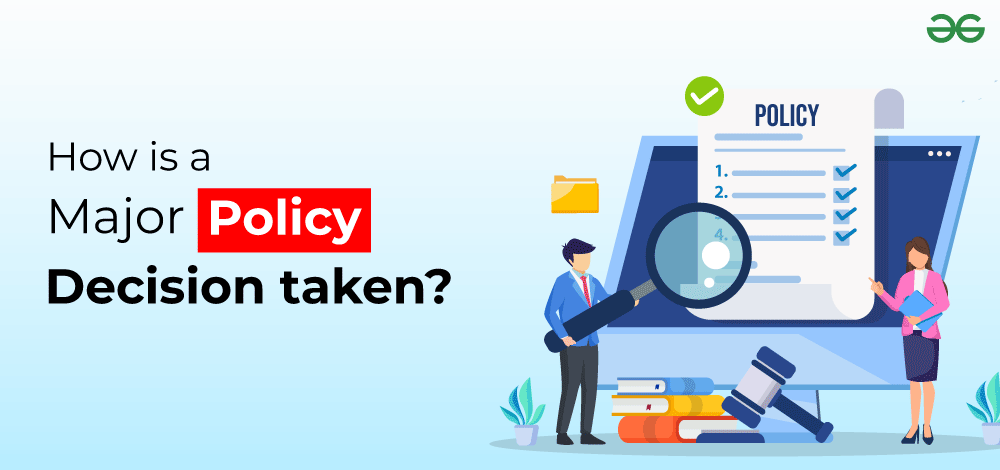How is a Major Policy Decision taken?
Last Updated :
23 Jan, 2024
Most important decisions of the government are taken by the Prime Minister as well as cabinet ministers. According to the Constitution of India, the decision-making power of the government is given to the Prime Minister, who is the head of the government and the president is the head of state.
The rulers of democracy must work with and within institutions. They come across three institutions in this process: legislative, executive, and judiciary, all of which play a crucial part in major decisions.

Major Policy Decision taken
Process of making a large policy decision
A government order is used to make a major policy decision. It is necessary to understand the process of making a key policy decision to understand how government orders are issued.
Government Order
- Issuing Government Orders: A government order is a written directive signed by a government official on a specific topic (office). An Office Memorandum is what it’s called. For example, the Government of India issued one such order in 1990 (August 13th) regarding a key policy decision. It allows for a 27 percent quota in government offices and services for members of the Socially and Educationally Backward Classes (SEBC).
- Order-Issuing Controversy: Order-Issuing Controversy has sometimes resulted in a nationwide protest. Some of the demonstrations have become violent. As a result, the topic is hotly contested in the media, with various points of view and viewpoints.
- Appeals to Stay the Order’s Implementation: Several individuals and organizations have filed lawsuits in court to stop the order’s implementation. They are requesting that the order be declared invalid and that its execution be halted.
- Court Intervention and Order Modifications: The Supreme Court or High Courts assess the order’s constitutional legitimacy and alter it if any constitutional requirements are violated.
Primary Decision Makers
In a government order, the significant decision-makers are:
- President: He is the country’s highest official authority and serves as the country’s head of state.
- Prime Minister: He is the head of government and is in charge of all government functions. In Cabinet sessions, he makes the majority of the decisions.
- The President and two houses, the Lok Sabha and the Rajya Sabha make up Parliament.
Report of the Mandal Commission
The Second Backward Classes Commission was established by the Indian government in 1979. It was known as the Mandal Commission, and it was led by BP Mandal. The commission issued its findings in 1980, recommending that the socially and educationally disadvantaged be given a 27 percent quota in government posts. The study and recommendations were debated in Parliament but not carried out.
The cabinet of the former Janata Dal Government, led by VP Singh, took a formal decision on the Mandal Commission report’s implementation on August 6, 1990. The decision was announced by the Prime Minister to both houses of Parliament. The Cabinet’s decision was forwarded to the Department of Personnel and Training. Following the government’s decision, newspapers and magazines were flooded with many viewpoints and thoughts. It sparked large demonstrations and counter-demonstrations, some of which turned violent. People were outraged because the judgment had a huge impact on thousands of job chances.
Political Institutions are Required
Political institutions are structures formed in democracies to take and implement decisions, as well as to determine what is wrong and what is right in the event of disagreements. In our democracy, there are multiple such institutions at work.
- The Prime Minister and the Cabinet are the entities responsible for all major policy decisions.
- The civil officials, working collectively, are in charge of putting the minister’s choices into action.
- The Supreme Court is a court that hears and decides issues between citizens and the government.
Institutions are made up of laws and regulations that limit the power of the leaders. Democracy cannot exist without the functions of the responsibilities allocated to political institutions. Institutions make it harder to make a rapid and good decisions. However, they also make it more difficult to haste (make a hasty decision). As a result, democratic governments prioritize institutions.
FAQs on How a Major Decision is Taken
How is a major decision taken?
The Prime Minister of the head of government and exercises most of the governmental powers and takes the decisions of the cabinet meetings.
How is the major policy taken in India?
The legislature in India is responsible for making most of the laws, changing and also enunciating the policies, and the decisions taken by the ruling government are backed by the sanction of law.
What are the three major decision-makers in India?
Three major decision makers include legislature, executive, and judiciary.
Like Article
Suggest improvement
Share your thoughts in the comments
Please Login to comment...